|
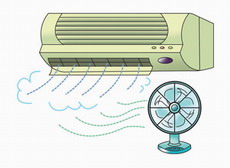 1.Less
AC, More Fan 1.Less
AC, More Fan
■Choose
air conditioners with energy labels
■The
temperature should be set at 26~28℃ and used in
combination
with fans.
■Every
degree up is 6% energy conserved.
■Clean
the filter every 2-3 weeks.
■Adding
a sun shading board outside can lower 75% of radiated
heat. |
|
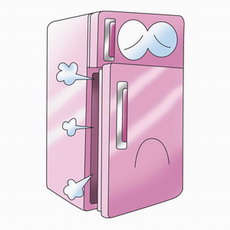
2.Open
the refrigerator less
■There
should be 10 cm between the wall and the refrigerator to
spread
the
heat.
■The
storage capacity should be around 80%, so the cold air
flow
won't be blocked.
■The
temperature should be appropriate, and not under extreme
coldness for too long.
■The
padding around the door should be tight so that the cold
air
doesn't leak.
■Don't
open the door too often or too long. |
|
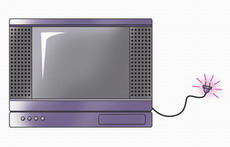 3.Turn
off the television and unplug it 3.Turn
off the television and unplug it
■Choose
Tv with energy labels. Unplug
it if not in use for a long time.
■The
back should not face windows, to avoid the sun.
■The
back of the TV should be 10 cm away from the wall.
■Avoid
long periods of TV, to avoid high temperatures and more
electricity. |
|
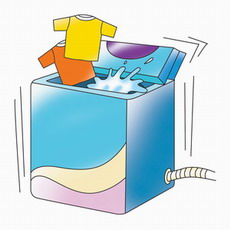 4.Wash
clothing in cold water, and dry them naturally 4.Wash
clothing in cold water, and dry them naturally
■Choose
washing machines with energy labels.
■Wash
your clothing when it reaches 70~80% of the max load,
and
choose the
most appropriate cleaning method.
■Nylon
only needs 1 minute to de-water, while normal clothing
needs 3.
■After
soaking for 20 minutes, the washing effect will be more
complete.
■Use
a natural way to dry clothing, the sun.
■Automatic
cleaning mode should be used according to how dirty the
load
is, and what type of washing liquid is used. |
|
 5.The
fan should be timed to "min" periodically 5.The
fan should be timed to "min" periodically
■Choose
fans with energy labels
■Use
"min" mode, to save energy and lower the noise.
■Choose
fans with timers, and choose according to the room size.
■Use
fans to bring in cool air from outside or in combination
with air conditioners, to improve the air flow. |
|
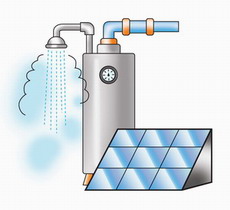 6.Use
solar powered water heaters 6.Use
solar powered water heaters
■Choose
water heaters with energy labels.
■Check
the batteries periodically, to avoid incomplete burning
of gas,
and check the
gas regularly, to avoid red flames.
■Wash
for around 10 minutes, showers are better than baths,
saving 2~3
times heated water.
■The
shorter the piping, the better. For longer pipes
insulation should be
added.
■Use
solar powered heaters, which can save up to 70% on fuel
prices. |
|
 7.Choose
high efficiency lighting 7.Choose
high efficiency lighting
■Choose
lighting with energy labels.
■Fluorescent
lighting uses about a third of energy compared to
incandescent lighting.
■Turn
off the light! Even if it's a short amount of time, it
can still save
energy.
■Lower
the amount of light bulbs used. Save energy and lower
the
amount of trash!
■Use
energy efficient lighting, like motion sensors and
timers.
■Light
bulbs and lighting should be wiped periodically to
enhance the
refraction. |
|
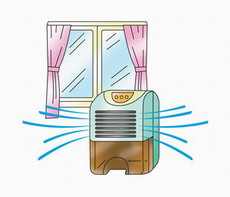 8.Close
doors and windows while dehumidifying. 8.Close
doors and windows while dehumidifying.
■Choose
dehumidifiers with energy labels.
■Close
the door and windows when dehumidifying to prevent humid
air
from entering.
■The
filter should be cleaned, to maintain clean and
circulating air.
■Put
the dehumidifier in a place with good circulation, and
avoid putting
it in corners. This will prevent the
circulation from being blocked.
■Dehumidifiers
should be put on solid ground, to avoid vibration and
noise. |
|
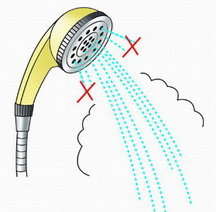 9.Use
water conserving shower heads 9.Use
water conserving shower heads
■Changing
the standard shower head (14.3 liters per minute) to a
water conserving (less than 11 liters a minute) one may
be the most effective water conserving measure you can
do at home. For a family, 16 minutes in the shower a day
can mean saving 30,000 liters of water a year, and in
addition, the 900 kilowatt hours of heating, and 200 kg
of carbon dioxide emission (350 kg for coal gas heaters,
450 for oil heaters). |
|
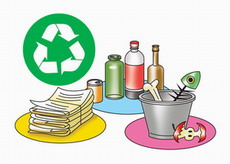 10.OK
Categorize your trash! 10.OK
Categorize your trash!
■Use
less paper, and reuse paper. Share newspapers, pass
reports
around,
and use waste paper as note paper.
■Recycle
paper. Recycled paper needs less than 50% of the
original
energy to
manufacture, and every ton of recycled paper means 19
trees
saved.
■Use
recycled cans, every ton means less than two thirds of
the original
energy
cost. |
|
 Pictures
from: Pictures
from: |
|
Extracted from "Global Warming, What Should We Do? Read
the Prescription in the Kyoto Protocol".
Project manager: Shin
Chen Yie Illustrations by: Shu Hwai Yang Published by
the Kaoshiung City Government EPA and the Third Nature
Publishing Co. |
|
 Resource: Resource: |
|
Energy Label Global Info Page
http://www.energylabel.org.tw/
Greenhouse Gas Miser Handbook
http://my.so-net.net.tw/gaia_hwang/air/ghbook/
MOEAEC Taiwan
http://www.moeaec.gov.tw
Energy and Resource Lab, Industrial Technology Research
Institute, http://www.erl.itri.org.tw
Energy Park, Taiwan
http://www.energypark.org.tw
|
